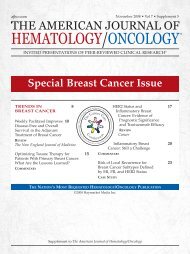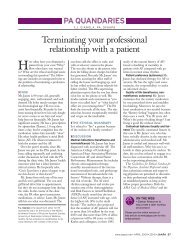Understanding palliative care - Haymarket Media Group
Understanding palliative care - Haymarket Media Group
Understanding palliative care - Haymarket Media Group
You also want an ePaper? Increase the reach of your titles
YUMPU automatically turns print PDFs into web optimized ePapers that Google loves.
<strong>Understanding</strong><br />
<strong>palliative</strong> <strong>care</strong><br />
An option that provides individuals with support<br />
and services that might not otherwise be possible.<br />
A SPECIAL SUPPLEMENT TO<br />
SPONSORED BY
Ever<strong>care</strong><br />
Palliative <strong>care</strong> offers<br />
an unmatched way<br />
to deliver muchneeded<br />
support and<br />
better quality of life<br />
at a time when it’s<br />
greatly needed<br />
Quality of life<br />
2 UNDERSTANDING PALLIATIVE CARE
E ach<br />
year, nearly two million older adults die from<br />
non-traumatic causes, many from chronic progressive<br />
illnesses. Sadly, individuals with complex<br />
illness are often unaware of <strong>palliative</strong> <strong>care</strong> services that<br />
can lend much-needed support and serve to enhance<br />
their quality of life over the course of their illness.<br />
Designed to meet the comprehensive spiritual, emotional<br />
and physical needs of those with complex illnesses,<br />
as well as the needs of their family <strong>care</strong>givers, <strong>palliative</strong><br />
<strong>care</strong> is a service whose value cannot be overestimated.<br />
Unfortunately, it’s one that is still being underutilized.<br />
Nowhere is that more apparent than in the realm of<br />
pain management. Research consistently shows that pain<br />
— a seriously debilitating symptom for many with<br />
chronic or progressive illness — is frequently undertreated<br />
in the long-term <strong>care</strong> environment, and beyond.<br />
It’s been shown that between 33% and 83% of nursing<br />
home residents experience ongoing pain that impairs<br />
mobility, leads to depression and diminishes quality of<br />
life. The fact that people are living longer with chronic<br />
illness further underscores the need for <strong>palliative</strong> <strong>care</strong>.<br />
“Pain is a big problem for many and that’s a real<br />
shame because it’s absolutely unnecessary. Just because<br />
someone has a (complex) illness that does not mean<br />
suffering needs to go along with it,” stressed Diane<br />
Meier, MD, FACP, director of the Center to Advance<br />
Palliative Care, New York.<br />
Pain isn’t the only symptom that can be alleviated<br />
through a well-designed and well-implemented <strong>palliative</strong><br />
<strong>care</strong> program, however. Depending upon the illness,<br />
individuals may also suffer from nausea,<br />
breathing problems, digestive disturbances, depression,<br />
anxiety and scores of other unpleasant and distressing<br />
symptoms that can rob them of their quality of<br />
life and make getting through each day a challenge.<br />
Not surprisingly, these disease management shortcomings<br />
dramatically differ from the needs and wants<br />
of individuals with complex illness. Numerous studies<br />
indicate that people with serious illness want vigorous<br />
treatment of pain and symptoms; relief from worry,<br />
anxiety and depression; ongoing communication<br />
about their illness and <strong>care</strong> options; coordinated, multidisciplinary<br />
<strong>care</strong> throughout their illness course, with<br />
anticipation of future <strong>care</strong> needs; decision-making support<br />
and assistance for themselves and their family<br />
<strong>care</strong>givers; and closely monitored, highly communicated<br />
<strong>care</strong> that lends a sense of safety and security in a<br />
sometimes confusing health<strong>care</strong> system.<br />
at the coreUNDERSTANDING<br />
A case for<br />
compassion<br />
Concerned that <strong>palliative</strong><br />
<strong>care</strong> is a costly<br />
program? Think again.<br />
Studies consistently<br />
show that patient-centered<br />
management of<br />
complex cases can<br />
reduce costs without<br />
shortening life. In fact,<br />
it’s been shown that<br />
reduced inpatient symptoms<br />
and fewer admissions,<br />
hospital days and<br />
emergency department<br />
visits are all benefits of<br />
patient-centered management.<br />
This approach<br />
has also been shown to<br />
cost $18,599 less over<br />
an 18-month period<br />
than non-patient-centered<br />
management of<br />
complex cases.<br />
Source: Sweeney, AMJC,<br />
February 2007<br />
Ever<strong>care</strong><br />
Overcoming misconceptions<br />
So why — despite <strong>palliative</strong> <strong>care</strong>’s far-reaching benefits<br />
— is the service still not being offered or accessed to its<br />
fullest? Experts believe misinformation and lingering<br />
misconceptions are, in great part, to blame.<br />
For starters, <strong>palliative</strong> <strong>care</strong> is often confused with hospice<br />
<strong>care</strong>. “Hospice is a form of <strong>palliative</strong> <strong>care</strong>, but it’s<br />
important to realize that <strong>palliative</strong> <strong>care</strong> is not synonymous<br />
with hospice. They are not one and the same,”<br />
said Stephen Connor, Ph.D., vice president for research<br />
and international development, National Hospital and<br />
Palliative Care Organization, Alexandria, VA.<br />
“What some people don’t understand is you can<br />
receive <strong>palliative</strong> <strong>care</strong> while still receiving or seeking<br />
curative treatments,” Connor added. He noted that<br />
those receiving <strong>palliative</strong> <strong>care</strong> not only benefit from<br />
relief of suffering, but also <strong>care</strong> teams working in tandem<br />
to devise the best <strong>care</strong> and support plans throughout<br />
the course of illness.<br />
The CAPC stresses that <strong>palliative</strong> <strong>care</strong> actually<br />
affirms life by supporting the patient’s and family’s<br />
goals for the future, including their hopes for cure or<br />
life-prolongation, as well as their hopes for peace and<br />
dignity throughout the course of illness, the dying<br />
process and death.<br />
At the heart of those goals are interdisciplinary <strong>care</strong><br />
teams that include medical and nursing specialists,<br />
social workers, counselors, pharmacists, therapists,<br />
nutritionists, clergy and other health professionals<br />
as needed.<br />
The team works in partnership with the patient or<br />
resident’s primary physician to expand traditional disease-model<br />
medical treatments to include the goals of<br />
enhancing quality of life for patients and family members,<br />
help with decision-making, and provide opportunities<br />
for personal growth.<br />
Another common and damaging misconception is<br />
that managing pain with opioid analgesics poses a toxicity<br />
risk that can hasten the dying process and place<br />
patients in a drug-induced fog.<br />
“People believe that pain medication kills, but the<br />
reality is pain is (what’s very bad for a person’s health),”<br />
Meier stressed. She explained that more than 90% of<br />
pain episodes and other symptoms can be effectively<br />
treated with standard analgesic therapies provided and<br />
closely monitored by a <strong>palliative</strong> <strong>care</strong> program. “Pain<br />
that goes untreated is the problem – not the drugs that<br />
manage it.”<br />
PALLIATIVE CARE 3
Ever<strong>care</strong><br />
Improving <strong>care</strong>, curbing costs<br />
The benefits of <strong>palliative</strong> <strong>care</strong> programs reach into fiscal<br />
realms as well. Research shows that because <strong>palliative</strong><br />
<strong>care</strong> works to prevent and relieve suffering, fewer<br />
people receiving the services require hospital visits and<br />
stays. Palliative <strong>care</strong> also helps ease the transition<br />
between <strong>care</strong> settings, which can further drive patient<br />
satisfaction while steering them to the most appropriate<br />
health<strong>care</strong> resources throughout their illness course.<br />
Even if a patient does require hospitalization, the costs<br />
for those receiving <strong>palliative</strong> <strong>care</strong> consultation are significantly<br />
less than for those who don’t. Live discharge costs<br />
for <strong>palliative</strong> <strong>care</strong> patients who receive intensive <strong>care</strong> are<br />
roughly $183 less per day than those who receive usual<br />
<strong>care</strong>. Care for end-of-life <strong>palliative</strong> <strong>care</strong> patients who<br />
receive intensive <strong>care</strong> and die in a hospital is approximately<br />
$446 less per day than those non-<strong>palliative</strong> <strong>care</strong><br />
patients, according to a 2007 study published in the<br />
Journal of the American Geriatrics Society.<br />
“Complex patients with advanced illness and multiple<br />
comorbidities are among the most expensive cases<br />
in health<strong>care</strong>,” confirmed Mark Leenay, M.D., MS,<br />
chief medical officer, Ever<strong>care</strong> Hospice and Palliative<br />
Care, citing a study published in the February 2007<br />
issue of the American Journal of Cardiology.<br />
“There’s no correlation between the prevalence of<br />
severe chronic illness and total Medi<strong>care</strong> spending,”<br />
continued Dr. Leenay. He did point out, however, the<br />
high correlation between Medi<strong>care</strong> spending and days<br />
spent in the hospital in the last six months, and an even<br />
stronger correlation between Medi<strong>care</strong> spending and<br />
doctor visits in the last six months of life.<br />
According to the 2006 Dartmouth Atlas of Health<br />
Care, if the resource utilization of efficient providers and<br />
systems was implemented nationally, it would reduce<br />
spending for those with severe chronic illness by 30%.<br />
The most physically, emotionally and spiritually fulfilled individuals<br />
are those who are able to stay focused on the things they love<br />
– and those who are chronically or terminally ill are certainly no<br />
exception.<br />
Palliative <strong>care</strong> should embrace each individual’s needs, while<br />
encouraging them, whenever possible, to stay engaged in their<br />
favorite activities or interests. More specifically, <strong>palliative</strong> and<br />
hospice <strong>care</strong> should be shaped by a deep commitment to celebrate<br />
who a patient is as a complete person, emphasizing not just<br />
what they need while they are ill or in their end stages of life, but<br />
what has been meaningful to them throughout their life.<br />
For 89-year-old Virginia Frizzell, it was the company and comfort of<br />
a volunteer and her therapy animals — a horse and a dog — that<br />
helped create an enriching hospice experience (see her photo on<br />
page 2). Despite being very weak from incurable pancreatic cancer,<br />
Frizzell was able to live independently with the support of in-home<br />
<strong>care</strong> and spend quality time with friends and family.<br />
Finding its stride<br />
Although <strong>palliative</strong> <strong>care</strong> is still underutilized, there’s no<br />
question the benefits, both to the patient and families and<br />
to the health<strong>care</strong> system, have led to greater penetration.<br />
A 2007 survey of 4,103 hospitals by the American<br />
Hospital Association revealed more than 30% have a<br />
<strong>palliative</strong> <strong>care</strong> program. The amount jumps to 70% for<br />
hospitals with more than 75 beds. VA hospitals reported<br />
almost 100% <strong>palliative</strong> <strong>care</strong> penetration.<br />
Still, Meier and Connor stressed there’s a well-documented<br />
need for evidence-based <strong>palliative</strong> <strong>care</strong><br />
research to promote more wide-spread support, access<br />
and implementation of the program across the <strong>care</strong><br />
continuum.<br />
The National Consensus Project for Quality<br />
Palliative Care states that further promotion and<br />
support of <strong>palliative</strong> <strong>care</strong> in the U.S. can be driven by<br />
ongoing health professional education in <strong>palliative</strong><br />
<strong>care</strong> principles and practice; increasing access to<br />
<strong>palliative</strong> <strong>care</strong> specialists across the <strong>care</strong> continuum;<br />
and promoting timely access to hospice services to all<br />
eligible patients.<br />
Some of those goals are currently being addressed<br />
by the Joint Commission. Later this year, the agency<br />
will be implementing <strong>palliative</strong> <strong>care</strong> standards as part<br />
of its new Health Care Services Certification Program.<br />
“The proposed standards emphasize the importance<br />
of patient-centered <strong>care</strong> and teamwork in focusing<br />
on the front line of service delivery,” noted Chuck<br />
Mowll, executive vice president, Business Development,<br />
Government and External Relations, The Joint<br />
Commission.<br />
The standards, expected to be launched in August,<br />
cover important aspects related to program management,<br />
providing <strong>care</strong>, managing patient information,<br />
and improving performance.<br />
Meeting the needs of individuals — while focusing on what’s important<br />
4 UNDERSTANDING PALLIATIVE CARE<br />
Pain by<br />
numbers<br />
33-88: Percentage of<br />
nursing home residents<br />
with ongoing pain that<br />
impairs mobility and<br />
robs quality of life 1,2<br />
50: Percentage of<br />
patients who report<br />
moderate or severe<br />
pain at least half the<br />
time in their last three<br />
days of life 3<br />
65: Percentage of <strong>care</strong>givers<br />
of dying patients<br />
who cite inadequate<br />
control of suffering 3<br />
References<br />
1. Miller SC, Mor V, Teno J.<br />
Hospice enrollment and<br />
pain assessment and management<br />
in nursing homes.<br />
J Pain Symptom Manage.<br />
2003;26:791-799.<br />
2. Teno JM, Weitzen S,<br />
Wetle T, Mor V. Persistent<br />
pain in nursing home residents.<br />
JAMA.<br />
2001;285:2081.<br />
3. Leenay M, Opening a<br />
Dialogue: Advance Care<br />
Planning. 2007<br />
“A large part of what we do is spend time one-on-one with<br />
patients, reflecting on their lives to get a better understanding of<br />
what will help them most as they approach this final phase,” noted<br />
Anne Kidd, the hospice social worker who coordinated Virginia’s<br />
home services and regularly monitored her overall condition and<br />
well being.<br />
Knowing Frizzell’s love of horses and riding, Kidd contacted the<br />
volunteer coordinator for their hospice program to determine<br />
whether a horse visit could be arranged. They immediately<br />
reached out to another volunteer who jumped at the chance to<br />
bring her horse, Cody, to Frizzell’s home.<br />
“Because Virginia wasn’t able to travel much, we knew we’d need<br />
to bring the horse to her,” Kidd explained. The joy in Virginia’s face<br />
as she connected with Cody was unmistakable, she added. “It was<br />
so wonderful for her, so rewarding and calming. In fact, Virginia<br />
told us: ‘This is the best day of my life.’”
Hospice <strong>care</strong> should be about giving,<br />
not giving up.<br />
Preparing for end-of-life doesn't have to mean giving up. Ever<strong>care</strong> Hospice and Palliative<br />
Care goes beyond basic requirements to provide coverage of <strong>care</strong> for you and your<br />
loved one physically, emotionally and spiritually as end-of-life approaches. Unlike some<br />
programs, there is no restriction on the kind of therapies your loved one may receive with<br />
Ever<strong>care</strong>. And they get the extra attention of an Ever<strong>care</strong> Hospice Physician. So youcan<br />
rest assured they'll continue getting the best <strong>care</strong> possible when they need it most.<br />
Learn more about hospice and <strong>palliative</strong> <strong>care</strong> today:<br />
1-877-431- 0790 (ID# 172)<br />
Ever<strong>care</strong>HealthPlans.com/Hospice<br />
Ever<strong>care</strong> ® Hospice & Palliative Care services are offered by United Health<strong>care</strong> Insurance Company. ©2008 United HealthCare Services, Inc.
Ever<strong>care</strong><br />
5<br />
1Palliative <strong>care</strong> is appropriate at any point in an<br />
illness and can be administered in conjunction<br />
with curative treatments. The goal of <strong>palliative</strong><br />
<strong>care</strong> is to anticipate, prevent and relieve suffering and<br />
symptoms — regardless of the stage of a disease — and<br />
optimize a patient’s quality of life. Palliative <strong>care</strong> is not<br />
restricted to end-of-life <strong>care</strong> and often is provided<br />
alongside curative and disease-modifying treatments.<br />
It is generally high-touch and low-tech, focusing on the<br />
right <strong>care</strong> for the right patient at the right time.<br />
2Pain management is often inadequate in individuals<br />
who could benefit from it the most.<br />
Although pain is highly prevalent in patients<br />
with advanced illness, undertreatment is common.<br />
According to the Journal of Pain and Symptom Management,<br />
undertreatment of pain in those with advanced<br />
disease is a far more pressing concern than the risk of<br />
hastened death.* Palliative <strong>care</strong> includes very aggressive,<br />
individualized measures to control a patient’s pain<br />
and other distressing symptoms.<br />
3Palliative <strong>care</strong> is not a one-size-fits-all<br />
approach. Palliative <strong>care</strong> addresses the continuum<br />
of physical, social and spiritual needs and<br />
facilitates patient autonomy, access to information and<br />
personal choice. It is highly customized, with the<br />
utmost respect for a patient’s values, culture, wishes<br />
and dignity. Palliative <strong>care</strong> also reaches out to family<br />
members and loved ones, recognizing their unique<br />
concerns and issues.<br />
6 UNDERSTANDING PALLIATIVE CARE<br />
Unique<br />
features<br />
“Palliative<br />
<strong>care</strong> empowers<br />
patients<br />
with advanced<br />
illness to live<br />
as fully and<br />
comfortably<br />
as possible.”<br />
Dr. Mark Leenay,<br />
Chief Medical<br />
Officer<br />
Ever<strong>care</strong> Hospice<br />
and Palliative Care<br />
Palliative <strong>care</strong> is different,<br />
notes Dr. Mark Leenay<br />
4The most effective <strong>palliative</strong> <strong>care</strong> involves<br />
advanced <strong>care</strong> planning and multi-disciplinary<br />
involvement. Palliative <strong>care</strong> revolves around<br />
the “whole person” and is provided by interdisciplinary<br />
teams. Care includes physician consultation and<br />
a broad range of services for the patient and family,<br />
including the support of nurses, chaplains, social<br />
workers, therapists and volunteers. Palliative <strong>care</strong> also<br />
can be a time to gather information about how an illness<br />
is likely to progress, including initial planning for<br />
long-term <strong>care</strong> needs.<br />
5Effectively administered <strong>palliative</strong> <strong>care</strong> can<br />
offer a cost benefit to health<strong>care</strong> organizations,<br />
while also enhancing quality of life for those<br />
who receive it. Patients with advanced illness generally<br />
have the highest costs in health<strong>care</strong>. Studies demonstrate<br />
that a patient-centered approach to <strong>care</strong> can<br />
reduce patient symptoms; lower hospital admissions,<br />
total hospital days and ER visits, and eliminate inappropriate<br />
or unnecessary interventions — all with no<br />
reduction in the length of a patient’s life. Palliative <strong>care</strong><br />
can play a direct role in lowering overall costs without<br />
shortening life.<br />
* Portenoy RK, Sibirceva U, Smout R, et al. Opioid Use and Survival at<br />
the End of Life: A Survey of a Hospice Population. J Pain Symptom<br />
Manage. 2006; 32:532-540.
There when you<br />
need us most<br />
Ever<strong>care</strong> Hospice & Palliative Care provides<br />
compassionate, individualized services to<br />
those with advanced illnesses and those nearing<br />
end-of-life, wherever they reside —<br />
whether in a private home, nursing home,<br />
assisted living facility or inpatient setting.<br />
Ever<strong>care</strong>’s experienced staff is part of an interdisciplinary<br />
team dedicated to meeting the<br />
physical, psychological and spiritual needs of<br />
residents and their families. By working<br />
closely with residents and their family members,<br />
Ever<strong>care</strong> provides a tailored, personal<br />
approach that delivers comprehensive <strong>care</strong><br />
solutions. Ever<strong>care</strong> Hospice & Palliative Care<br />
is available in many major U.S. cities:<br />
Atlanta<br />
3720 DaVinci Court, Suite 400<br />
Norcross, GA 30092<br />
(770) 417-2018 (local)<br />
(800) 700-0859 (toll free)<br />
(770) 417-2020 (fax)<br />
Birmingham, AL<br />
33 Inverness Center Parkway, Suite 350<br />
Hoover, AL 35242<br />
(205) 437-8655 (local)<br />
(800) 985-3305 (toll free)<br />
(205) 437-8540 (fax)<br />
Boston<br />
950 Winter St., Suite 4830<br />
Waltham, MA 02451<br />
(781) 472-8640 (local)<br />
(800) 956-1276 (toll free)<br />
(781) 472-8747 (fax)<br />
Cincinnati<br />
9050 Centre Pointe Drive, Suite 400<br />
West Chester, OH 45069<br />
(513) 682-4040 (local)<br />
(888) 866-8286 (toll free)<br />
(513) 682-4044 (fax)<br />
Colorado Springs<br />
5450 Tech Center Drive, Bldg. 1, Suite 120<br />
Colorado Springs, CO 80919<br />
(719) 265-1100 (local)<br />
(866) 840-9253 (toll free)<br />
(719) 265-1101 (fax)<br />
Columbia, MD<br />
6095 Marshalee Drive<br />
Elkridge, MD 21075<br />
(410) 379-3599 (local)<br />
(800) 543-0696 (toll free)<br />
(410) 379-3554 (fax)<br />
Denver<br />
6455 S. Yosemite St. 6th Floor<br />
Englewood, CO 80111<br />
(303) 714-2400 (local)<br />
(888) 437-4673 (toll free)<br />
(303) 714-2396 (fax)<br />
Houston<br />
9702 Bissonnet, Suite 2200W<br />
Houston, TX 77036<br />
(713) 219-6490 (local)<br />
(888) 303-6166 (toll free)<br />
(713) 219-6491 (fax)<br />
Macon, GA<br />
4875 Riverside Dr., Suite 104<br />
Macon, GA 31210<br />
(478) 812-9299 (local)<br />
(866) 846-1310 (toll free)<br />
(478) 812-9270 (fax)<br />
Phoenix<br />
3141 North Third Avenue<br />
Phoenix, AZ 85013<br />
(602) 749-5900 (local)<br />
(866) 658-4658 (toll free)<br />
(602) 749-5999 (fax)<br />
Sterling, VA<br />
21515 Ridgetop Circle, Suite 330<br />
Sterling, VA 20166<br />
(703) 788-1770 (local)<br />
(800) 245-1384 (toll free)<br />
(703) 788-1779 (fax)<br />
St. Louis<br />
13655 Riverport Drive<br />
Maryland Heights, MO 63043<br />
(314) 592-3670 (local)<br />
(800) 213-4188 (toll free)<br />
(314) 592-3681 (fax)<br />
Tucson, AZ<br />
17 West Wetmore, Suite 100<br />
Tucson, AZ 85705<br />
(520) 407-8000 (local)<br />
(877) 233-2902 (toll free)<br />
(520) 407-8001 (fax)<br />
Vienna, VA<br />
8245 Boone Blvd., Suite 401<br />
Vienna, VA 22182<br />
(703) 762-1600 (local)<br />
(888) 909-4474 (toll free)<br />
(703) 762-1690 (fax)<br />
Ever<strong>care</strong><br />
For more information about Ever<strong>care</strong><br />
Hospice & Palliative Care, visit<br />
www.ever<strong>care</strong>hospice.com.<br />
UNDERSTANDING PALLIATIVE CARE 7
End-of-life <strong>care</strong> doesn’t have to mean<br />
the end-of-<strong>care</strong>.<br />
Preparing for end-of-life doesn't have to mean giving up. Ever<strong>care</strong> Hospice and Palliative<br />
Care goes beyond basic requirements to provide coverage of <strong>care</strong> for you and your<br />
loved one physically, emotionally and spiritually as end-of-life approaches. Unlike some<br />
programs, there is no restriction on the kind of therapies your loved one may receive with<br />
Ever<strong>care</strong>. And they get the extra attention of an Ever<strong>care</strong> Hospice Physician. So youcan<br />
rest assured they'll continue getting the best <strong>care</strong> possible when they need it most.<br />
Learn more about hospice and <strong>palliative</strong> <strong>care</strong> today:<br />
1-877-431- 0790 (ID# 173)<br />
Ever<strong>care</strong>HealthPlans.com/Hospice<br />
Ever<strong>care</strong> ® Hospice & Palliative Care services are offered by United Health<strong>care</strong> Insurance Company. ©2008 United HealthCare Services, Inc.
















